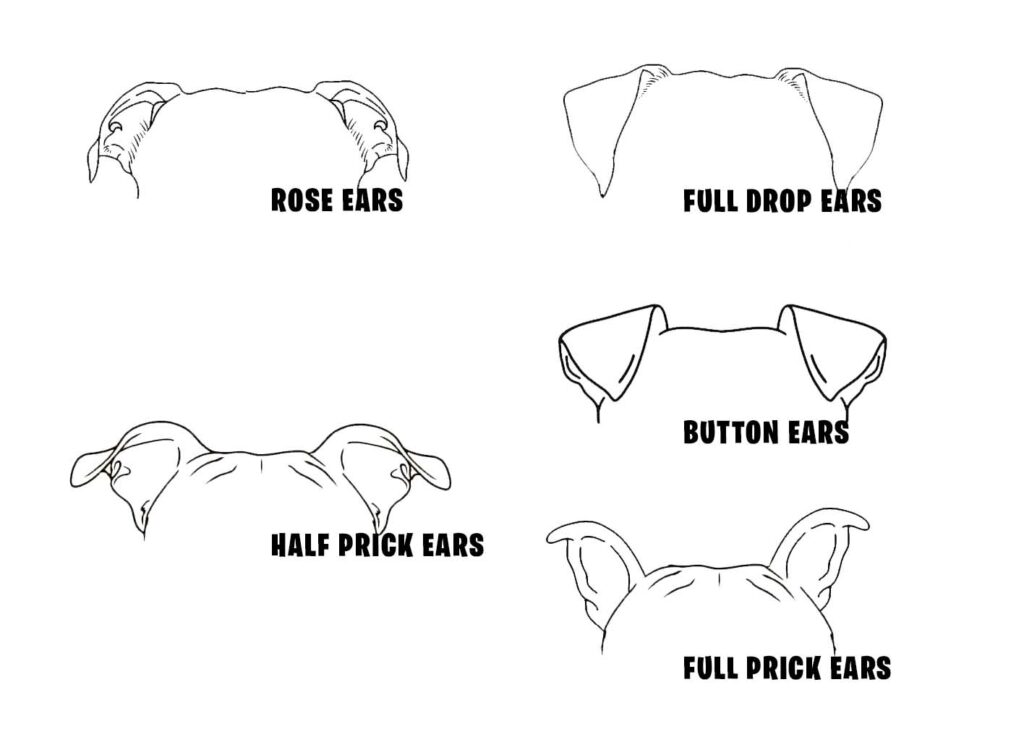Ear types in Staffordshire Bull Terrier

Rose Ears (Ideal Standard)
- The ears fold back and slightly outward, exposing part of the inner ear.
- They should not stand erect or flop forward.
- This is the most desirable ear shape for Staffordshire Bull Terriers according to breed standards.
Half-Prick Ears (Acceptable)
- The ears are partially erect, with the tips folding forward slightly.
- They should not stand fully upright.
- Similar to the ear shape seen in some Border Collies or Bull Terriers.
Pricked Ears (Not Desired)
- Ears stand fully upright like a German Shepherd’s.
- This is not typical for a Staffordshire Bull Terrier.
Button Ears (Not Desired)
- The ear folds forward, covering the inner ear.
- More common in Fox Terriers but incorrect for a Staffy.
Full Drop Ears (Not Desired)
- The ears hang completely downward without any fold.

Taping is not always necessary for Staffordshire Bull Terrier ears, as most will develop their natural shape over time.
However, some puppies may need a little help if their ears aren’t folding correctly into the classic rose shape.
Why Do Some Puppies Need Help?
- Genetics: If a puppy’s parents had pricked or floppy ears, the puppy may inherit the same trait.
- Teething Phase: Between 3-6 months, teething can cause ears to change shape temporarily due to shifting calcium levels. Some ears that start as rose-shaped may begin to stand up or flop forward.
- Weak Cartilage: If the cartilage in the ear is too soft, the ear may not hold its intended shape.
The Role of Nutrition in Ear Development
A balanced diet is crucial for strong cartilage and proper ear development. Nutritional deficiencies can weaken ear cartilage, making it harder for ears to form their correct shape. To support ear health, ensure your puppy gets:
High-quality protein (for muscle and tissue development)
Omega-3 & Omega-6 fatty acids (for skin and cartilage strength)
Calcium & phosphorus (for bone and cartilage support, but avoid excess)
Vitamin C & E (for collagen production, which helps cartilage form properly)
Glucosamine and Chondroitin are essential for cartilage development.
Should You Tape Your Staffy’s Ears?
- If your puppy’s ears are consistently standing up or flopping forward after teething, taping might help encourage the correct rose shape.
- However, taping should be done gently and only as a temporary aid.
- In most cases, proper nutrition, time, and patience are enough for natural ear development.

Taping a dog’s ears is a gentle, temporary aid and should never cause pain or distress. The goal is to encourage proper ear positioning without forcing an unnatural shape.
No Pain, Only Gentle Guidance
- Taping should always be light and comfortable for the puppy.
- Never use tight or restrictive taping that could cut off circulation or cause discomfort.
- If your puppy shows signs of pain, irritation, or excessive scratching, remove the tape immediately.
Respecting Natural Development
- Many puppies’ ears correct themselves naturally as they grow.
- Taping is only a mild encouragement, not a requirement.
- If your puppy’s ears remain upright or floppy, it is purely cosmetic and does not affect their health or personality.
Safe & Temporary Solution
- Always use skin-friendly, breathable tape (such as sports or medical tape).
- Never force an ear shape that does not fit the dog’s natural ear cartilage.
- If unsure, consult a veterinarian or experienced breeder before attempting taping.
Ear Taping
Taping your Staffordshire Bull Terrier’s ears can help encourage the natural “rose ear” shape, where the ear folds back and to the side, rather than standing upright or flopping forward. Here’s how to do it properly:
What You’ll Need:
- Sports tape or medical tape (gentle on the skin)
- Scissors
- Treats (to keep your pup relaxed)
Step-by-Step Guide:
1. Prepare Your Dog
- Choose a quiet, distraction-free space.
- Ensure your dog is calm—play with them beforehand to burn off excess energy.
- Use treats to build trust and make the experience positive.
2. Position the Ears Correctly
- Gently fold each ear into the desired “rose ear” shape.
- The ear should naturally fold back and slightly outward, not standing up or flopping forward.
3. Apply the Tape
- Cut a piece of medical tape about.
- Hold the ear in the correct position and apply the tape.
- Avoid wrapping too tightly—your dog should still be comfortable.
4. Monitor and Maintain
- Leave the tape on for about 3 days, then remove it and check the progress.
- If the ears are not holding shape, reapply the tape after a day or two of rest.
- Continue this process for a few weeks or until the ears naturally settle in the rose position.
5. Be Patient
- Not all Staffy ears will naturally form the perfect rose shape, but consistent taping can help guide them.
- If your dog keeps removing the tape, try distracting them with toys or treats.
- If there is damage to the ears (for any reason) STOP taping immediately!
Your Dog’s Comfort Comes First!
A happy, healthy puppy is more important than perfect ears. Always prioritize gentle, safe methods and let nature take its course whenever possible.